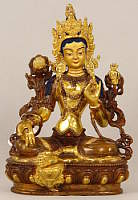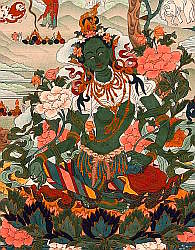| < Prev |
|---|
 Tara is a female Buddha and one of the most prominent female deities in Nepalese and Tibetan Buddhism. The name Tara means the "one who saves" and as the goddess of compassion, her job is to alleviate people from suffering. Like many Buddhist deities, she can have many emanations or forms. The most common are the White Tara and the Green Tara.
Tara is a female Buddha and one of the most prominent female deities in Nepalese and Tibetan Buddhism. The name Tara means the "one who saves" and as the goddess of compassion, her job is to alleviate people from suffering. Like many Buddhist deities, she can have many emanations or forms. The most common are the White Tara and the Green Tara.
The Story of Tara
There are different stories about Tara's origins as Buddhist deity, depending on which Tara one is referring too. A common story tells of a princess named Yeshey Dawa who lived a long time ago in another world,. She made offerings to the Buddha and as a result was offered to be reborn in the male form to help people. Believing instead gender to be no barrier, she prayed to be able to help people as a female. She received her wish and was reborn as a female goddess.
She took a vow before the Lord Buddha to help and protect beings from suffering and harm and not to eat until her work as done. For her devotion she was blessed and empowered by many Buddhas and later became known as "The Great Mother," from whom all Buddhas emerge.
White Tara
The White Tara is associated with Avalokiteshvara, the god of compassion, and considered his female counterpart. In some stories, they receive blessings and powers from the Buddhas together. Other stories of Tara's origins also tell that she came from his tears.
The White Tara is also known as the Tara of compassion and is associated with health, long life and healing. Tara is believed to protect human beings from suffering. The White Tara is often represented with many eyes and known as the Seven Eyes Tara - with extra eyes on her forehead, hands and feet. These extra eyes help her sense and understand the suffering of beings.
In figures, the White Tara is often seated with legs crossed and one arm bent and raised, crowned and surrounded with decorations. She also has pure white skin that is compared to the moon and the light it offers.
Green Tara
 The Green Tara is shown as a green skinned girl. Unlike the White Tara she does not sit cross legged but rather her right leg is out, ready to get up in order to help people. Her male counterpart is Amoghasiddhi, the god of action.
The Green Tara is shown as a green skinned girl. Unlike the White Tara she does not sit cross legged but rather her right leg is out, ready to get up in order to help people. Her male counterpart is Amoghasiddhi, the god of action.
The Green Tara is associated with enlightened activity and helps people overcome fears and anxieties. She saves people from the eight "obscurations" or flaws and their representations: pride (lion), delusions (wild elephants), hatred (fires), envy (snake), fanatical views, greed and avarice (bandits and thieves), (prisons and bondage), lust (floods) and doubt (demons).
The Green Tara is also said to have mortal origins or connections with the two princesses who married the Tibetan King Songtsen Gampo (ca. 617 - 650). This King is supposed to have brought Buddhism to Tibet for the first time.
Figures of Tara
Tara is one of the female deities and in figures she is often depicted with a soft smile. Figures of both the Green and White Tara are similar in form. Her expression is often soft and benevolent. Her eyes have a sympathetic quality to them. Tara figures also wear a great deal of ornamental jewelry.
The White Tara may have more than two eyes to aid her in alleviating suffering. The Green Tara often holds a half closed lotus or waterlily in her hand.
Of the twenty-one Taras, the Green and White Tara are the most common and most important. Other Taras include the Black Tara (power) and the Yellow Tara (wealth).
Dieter Wanczura







